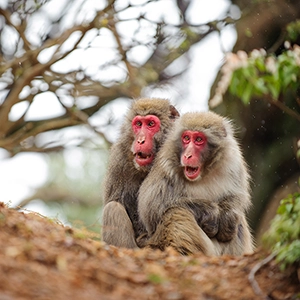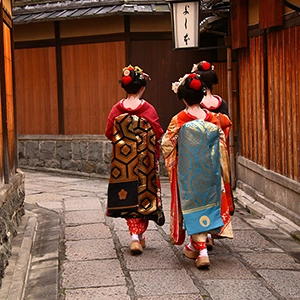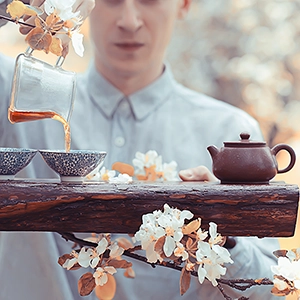Best Things To Do In Kyoto - 2023 Visitors Guide

Discover the Amazing Things To Do In Kyoto Japan: A Journey Through Japan's Cultural Gem
Looking for Things to do in Kyoto? Regarded as Japan's most beautiful city, Kyoto offers a unique blend of traditional culture, historical landmarks, and stunning natural beauty. From serene temples and sublime gardens to bustling traditional markets and cultural experiences, there's an abundance of things to do in this timeless city.
Fushimi Inari Shrine
At the top of the must-see list is the Fushimi Inari Shrine, known for its famous Torii gate pathway. This iconic walkway is made up of thousands of vibrant orange Torii gates, creating a tunnel-like structure that trails up the Inari Mountain. The shrine is dedicated to the Shinto god of rice and agriculture and provides a unique spiritual experience, as well as incredible photo opportunities.
Kinkaku-ji Temple
Another must-see in Kyoto is the Kinkaku-ji Temple, or the Golden Pavilion. This Zen Buddhist temple is covered in gold leaf, beautifully reflecting on the pond below. The sight of the temple, surrounded by lush gardens and set against a backdrop of Kyoto's stunning landscapes, is a visual treat you should not miss.
Arashiyama Bamboo Grove
The Arashiyama Bamboo Grove provides an extraordinary sensory experience. The sight of the towering bamboo trees swaying in the wind, the rustling sound of the leaves, and the serenity of the place truly make it a magical experience. Located in the Arashiyama district, it's best visited in the early morning or late evening to avoid crowds.
Gion District
The Gion District offers a glimpse into the traditional side of Kyoto. Known as Kyoto's geisha district, Gion is teeming with traditional tea houses, wooden machiya houses, exclusive restaurants, and artisan shops. The district comes alive in the evening, with maiko (apprentice geisha) and geisha seen scurrying down the cobblestone streets to their appointments.
Nishiki Market
The Nishiki Market, often referred to as "Kyoto's Kitchen," is a vibrant food market located in downtown Kyoto. This five-block-long street is packed with hundreds of stalls selling everything from fresh seafood and seasonal fruits to Kyoto's traditional sweets and pickles. Don't miss out on trying some of the local delicacies here.
Kyoto Imperial Palace and Gardens
The Kyoto Imperial Palace and its surrounding gardens offer a peaceful retreat right in the heart of the city. The palace was the residence of the Imperial family until the capital was moved to Tokyo. It's worth taking a stroll through the meticulously maintained gardens, admiring the traditional Japanese architecture, and perhaps even enjoying a picnic.
Kyoto Cuisine and Tea Ceremony
No visit to Kyoto would be complete without indulging in Kaiseki, the traditional multi-course Japanese dinner. Also, participating in a tea ceremony, where you can learn about and appreciate the intricate art of tea preparation, is a unique cultural experience. These traditions truly highlight the beauty of Kyoto's cultural heritage.
In essence, Kyoto is a city that seamlessly blends history, culture, and natural beauty. It captivates its visitors with its serene temples, majestic palaces, flavorful cuisine, and traditional cultural experiences. Whether it's your first visit or you're returning for more, Kyoto promises an unforgettable journey through the heart of Japan's cultural heritage.
Discover the Serenity of Togetsukyo Bridge Kyoto: A Jewel of Japanese Cultural Heritage
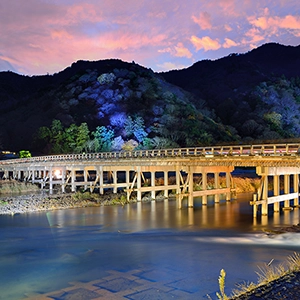
Nestled amidst the lush greenery and mountains of Western Kyoto, the Togetsukyo Bridge radiates the characteristic beauty, elegance, and tranquility that are synonymous with Japanese culture. Inextricably linked with the nation's history, Togetsukyo Bridge – which translates to "the bridge that crosses the moon" – is a must-visit destination for tourists and locals alike when visiting the ancient capital of Japan.
Constructed in 836 AD during the Heian period, the Togetsukyo Bridge, which spans across the Katsura River, is widely admired for its stunning reflection and perfect harmony with the surrounding scenic landscape. The bridge has borne witness to the changing of the seasons for well over a millennium, and the famed cherry blossoms in spring and vibrant autumn foliage serve as a stunning backdrop to its mesmerizing beauty.
A symbol of Kyoto's rich cultural fabric, the Togetsukyo Bridge beckons visitors to journey back in time and experience the soul and essence of Japan's ancient past. A leisurely stroll across this iconic landmark is a perfect way to revel in the serenity and subtle intricacies inherent in Japanese culture. No visit to Kyoto is complete without exploring the magnificent Togetsukyo Bridge and the enchanting village of Arashiyama that it connects to, steeped in history and natural beauty.
Explore the Wonders of the Hozu River: Take a Boat Ride and Embrace the Adventure

Are you ready for an unforgettable journey through the majestic sceneries of Japan? Take a boat ride on the Hozu River and you will find yourself on one of the most exhilarating trips amidst pristine waters, lush greenery, and dramatic rock formations that will leave you in awe.
Winding majestically through Kyoto Prefecture, the Hozu River, also known as the Hozugawa or Katsura River, lies beguilingly in the heart of Japan. Regarded as one of the best ways to experience the beauty of the natural landscape in the region, this riverine voyage showcases stunning panoramas of wildlife, stunning mountain ranges, and a rich tapestry of captivating colors.
As you embark on this thrilling adventure, be enthralled by skilled boatmen guiding your wooden boat through surging rapids and enchanting calm waters. Enjoy the thrill of each twist and turn while basking in the soothing atmosphere of untouched nature and the delicate ancient whispers of Japanese history. Perfect for families, friends, and nature enthusiasts, taking a boat ride on the Hozu River guarantees a marvellous, adrenaline-filled day you will never forget.
Plan your visit now and embark on this exciting and awe-inspiring journey through the timeless embrace of the Hozu River's breathtaking beauty.
Experience the Enchantment of the Arashiyama Bamboo Grove

Hidden away in the western outskirts of Kyoto, the enchanting Arashiyama Bamboo Grove is a fascinating natural wonder that every traveler must experience. This captivating forest has withstood the test of time, dating back to the Heian Period (794-1185), and it remains one of the most popular and iconic landmarks in Kyoto. As you wander through the sprawling bamboo paths, it's impossible not to be mesmerized by the towering green stalks that seem to touch the sky, softly rustling as the wind passes through them.
Stepping into the Arashiyama Bamboo Grove is an otherworldly experience, transporting visitors to a magical realm of tranquility, removed from the hustle and bustle of urban life. The grove is an eternally popular attraction all year round, with each season bringing its unique charm, from the fresh green leaves of spring to the warm golden hues of autumn.
The Arashiyama Bamboo Grove isn't just a feast for the eyes, but also offers visitors the chance to immerse themselves in Japanese culture. The nearby temples, such as Tenryu-ji and Daikaku-ji, provide a glimpse into Kyoto's rich and storied past. The combination of these sacred temples, together with the serene beauty of the bamboo grove, create an atmosphere of spiritual awakening that is sure to leave a lasting impression.
Prepare to be captivated by the enchanting beauty of the Arashiyama Bamboo Grove - this must-see destination in Kyoto is truly a gem that shouldn't be missed.
Connect with the beauty and serenity of the Tenryu-ji Temple
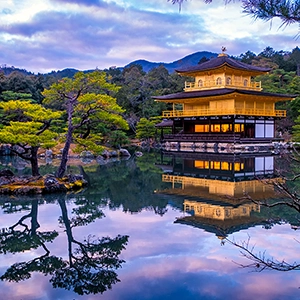
The Tenryu-ji Temple is an idyllic representation of Japanese culture and spirituality nestled among the lush green bamboo groves of Arashiyama, Kyoto. Founded in 1339 by the Ashikaga Shogunate, the temple is considered to be one of the 'Five Great Zen Temples of Kyoto' and is a designated UNESCO World Heritage Site.
Tenryu-ji Temple enjoys a rich history filled with tales of imperial patronage, shogunate politics, and Zen Buddhist philosophy. As the head temple of the Tenryu-ji branch of the Rinzai Zen sect, it continues to propagate the teachings of the revered master Musō Soseki, who served as the temple's first chief priest.
Visitors are welcomed into the temple grounds by exquisite and meticulously manicured gardens which embody the essence of Japanese horticulture. Tenryu-ji Temple's landscape garden, 'Sogenchi', is renowned as a national historic site and considered one of the oldest of its kind in Japan. As you meander along the temple's tranquil footpaths adorned with azure dragon art, marvel at the exquisite architecture, and savor the peaceful atmosphere, it is almost impossible not to be inspired by Tenryu-ji's timeless beauty and profound spirituality.
Embark on a journey to Tenryu-ji Temple – an extraordinary testament to Japan's cultural legacy, where history, nature, and Zen harmoniously converge.
Iwatayama Monkey Park: An Enchanting Encounter with Japan's Native Primates
When visiting the enchanting city of Kyoto, the Iwatayama Monkey Park is a must-visit for wildlife enthusiasts and animal lovers alike. Located in the lush, verdant hills of Arashiyama, a district on the western outskirts of Kyoto, the park offers visitors the unique opportunity to interact with and observe over 120 Japanese macaque monkeys, colloquially known as "snow monkeys," in their natural habitat.
As one embarks on the pleasant 20-minute hike through the thick green foliage, the stunning panoramic views of Kyoto city and Oi River add to the charms of this picturesque park. Upon reaching the summit, visitors will be welcomed by these playful and intelligent creatures, roaming freely through their forested home. The park's knowledgeable staff, present during feeding times, are always eager to share engaging insights about the distinct behaviors and fascinating lives of these captivating primates.
Iwatayama Monkey Park offers more than just an interactive walk through nature; it's an experience hard to forget as one steps into the mesmerizing world of the snow monkeys. So, when in Kyoto, make sure not to miss this exceptional opportunity to connect with our furry friends, a stone's throw away from the bustling city streets.
A Glimpse into the Alluring World of a Kimono Fashion Parade
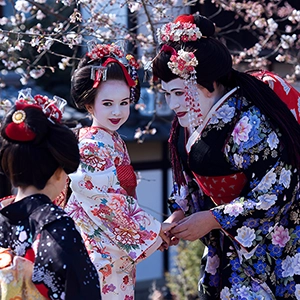
Kimono Fashion Parade- an exquisite celebration of a time-honored Japanese traditional garment that embodies the nation's rich cultural heritage, art, and craftsmanship. As various regions across Japan host these glamorous events, one can't help but be enchanted by the sheer elegance and beauty of the kimono.
The captivating Kimono Fashion Parade is a visual delight that draws innumerable tourists and locals alike, showcasing a stunning and diverse collection of kimonos. Participants take pride in wearing these magnificent, intricately designed garments that come in a myriad of colors, fabrics, and patterns- each reflecting the distinct story and identity of its wearer.
A vital aspect of the Kimono Fashion Parade is the beautiful interplay of historical and modern design elements, revealing the evolving nature of kimono fashion. One can witness striking contemporary designs masterfully blended with traditional artistry, making these events more than just a fashionable affair – a testament to Japan's ability to honor its past while adapting to modernity.
While participating or attending a Kimono Fashion Parade, one can't help but experience a deep sense of appreciation for the immense skill, dedication, and creativity of the artisans responsible for these wearable works of art. Indeed, the Kimono Fashion Parade captures the essence of Japan's unique spirit, taking spectators on a visual journey through generations of culture, history, and beauty. Don't miss the opportunity to witness the enchanting world of kimono fashion, where tradition, art, and style come together in a mesmerizing spectacle you wouldn't want to miss!
Kinkakuji Temple: Experience the Beauty, History and Rich Culture

Kyoto, a Japanese city rich in culture and history, is home to many World Heritage sites, with one of its most remarkable gems being the Kinkakuji Temple. Officially known as Rokuonji, this Zen Buddhist temple is widely recognized for its 'Golden Pavilion', making it an iconic symbol of Kyoto and an absolute must-visit when exploring this breathtaking city.
The Kinkakuji Temple dates back to the 14th century and was initially built as a retirement villa for Shogun Ashikaga Yoshimitsu. Upon his death, it was transformed into a Buddhist temple as per his wishes. The temple's most striking feature, the gold leaf coated pavilion, is an architectural marvel that has captivated tourists and pilgrims alike. The dazzling exterior contrasts brilliantly with its serene surroundings, as it stands elegantly beside a large pond, amidst lush gardens.
Behind its staggering beauty, the temple embodies deep symbolism and represents the extravagant Kitayama culture that flourished during Yoshimitsu's reign. Each of its three floors showcases distinct architectural styles, culminating in an artistic masterpiece.
Visiting the Kinkakuji Temple offers a unique opportunity to bask in its golden glow, while appreciating the intricate relationship between Zen Buddhism, nature, and Japanese history. Don't miss the chance to experience the undeniable allure of this fascinating destination.
Take in the Beauty and History of Nijo Castle
Nestled in the heart of Kyoto, Japan, Nijo Castle stands as a beautiful reminder of the country’s rich past. A designated UNESCO World Heritage Site, this marvelous structure transports visitors back to the era of the Tokugawa Shogunate. Constructed in 1603 on the orders of Tokugawa Ieyasu, the first shogun of the political dynasty, Nijo Castle symbolizes the power and prestige enjoyed by the ruling Tokugawa family during their tenure.
Nijo Castle is more than just an impressive fortress; it is a work of immense architectural significance. The castle's design is heavily influenced by both the Momoyama and Edo periods, creating a unique blend of styles. The stunning Ninomaru Palace is a prime example of this, featuring elegant sliding doors adorned with intricate golden leaf paintings and traditional tatami mat floors. The palace is surrounded by beautiful gardens, which are divided into three different landscaped areas, each boasting serene ponds, manicured lawns, and colorful flora.
A visit to Nijo Castle allows you to embrace and explore an important part of Japan's heritage. As you walk through its gates, you step back in time to witness the grandeur and sophistication that once defined one of the world's most powerful dynasties. Experience the striking juxtaposition of nature's allure and man's craftsmanship, all within the hallowed walls of Nijo Castle.
Savour the Culinary Wonderland of the Nishiki Market
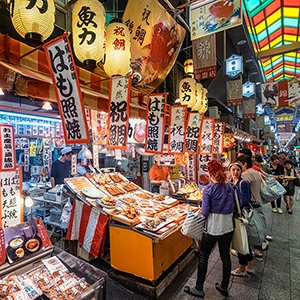
Nestled in the heart of Kyoto, Japan, lies a colorful and bustling culinary paradise that has been enchanting visitors for centuries. Called "Kyoto's Kitchen," Nishiki Market is a vibrant testament to Japanese gastronomy, offering an unforgettable sensory journey of tantalizing tastes, sights, and scents.
Stretching across five blocks, Nishiki Market comprises over 100 shops and restaurants offering an exquisite selection of fresh seafood, seasonal fruits, vegetables, and a myriad of delectable delicacies. As you meander through the bustling lanes, you'll be captivated by the sizzle of yakitori skewers and the aroma of authentic sushi, all prepared using the finest local ingredients.
But there's more to this market than meets the taste buds. Alongside Kyoto’s culinary delights, this marketplace is also an emporium for traditional Japanese crafts and souvenirs. With every turn, you’ll experience the city's cultural richness, making Nishiki Market an undeniable must-visit destination for every Kyoto traveler.
In a land famed for its culinary artistry, Nishiki Market stands as a gastronomic epicenter, ensuring that no trip to Kyoto is complete without indulging in this ultimate foodie's haven. So lace up your walking shoes, pack your appetite, and prepare to be entranced by the wonder of Nishiki Market.
Take a stroll along the Philosopher's Walk: A Pathway to Inspirational Beauty

Imagine strolling through a lush, verdant, and tranquil pathway while pondering the mysteries of the universe, much like the great philosophers of ancient history once did. If this scene sounds absolutely enchanting, then prepare to be captivated by the mesmerizing Philosopher's Walk.
Located in Kyoto, one of the ancient capitals of Japan, the Philosopher's Walk is a famous pedestrian trail that stretches approximately two kilometers along the Lake Biwa Canal. The name of the path derives from Japanese philosopher Nishida Kitaro, who was known to meditate and walk along this route every day. The trail provides visitors with a mesmerizing scenery throughout the year, with cherry blossoms and plum trees adorning the pathway in spring and the marvelously colored foliage in autumn.
The path is lined with traditional Japanese cafes, craft shops, temples, and shrines, including the impressive Eikando Temple, the picturesque Honen-in Temple, and the architecturally renowned Nanzen-ji Temple. Strolling along the Philosopher's Walk not only offers a serene and captivating experience, but it also serves as a reminder of the profound value of contemplation and self-reflection amidst the beauty of nature.
Embark on a journey along the Philosopher's Walk and uncover your own inner tranquility and connection with the natural world. Don't be surprised if you find yourself pondering the deeper questions of life while surrounded by this breathtaking landscape.
Delve into the mesmerizing world of the Gion Geisha District
Discover the Beauty and History of Nijo Castle in Kyoto, Japan>Discover the mesmerizing world of Gion, Kyoto's famous Geisha District, as you delve into the fascinating realm of traditional Japanese arts and culture. Nestled in the heart of Kyoto, the ancient capital of Japan, Gion epitomizes the essence of timeless elegance, offering a rare glimpse into the captivating lives of these enigmatic entertainers.
As you stroll along the cobblestone streets, the distinct allure of wooden teahouses and quaint historic buildings transports you back in time to the mid-18th century when this prominent district served as a thriving hub for the arts, attracting prominent playwrights, kabuki actors, and of course, the elusive Geisha.
Whether you chance upon a maiko, or apprentice geisha, adorned in resplendent garb or witness the graceful performances of skilled artists during exclusive teahouse engagements, every encounter with the artisans of Gion leaves an indelible impression of a bygone era when artistry, beauty, and poise held sway.
As custodians of Kyoto's rich cultural heritage, the Geisha of Gion remain firmly entrenched as symbols of sophistication and refinement, beckoning you to unearth the hidden gems of one of Japan's most iconic districts.
See This Amazing Japanese Artform: The Kyoto International Manga Museum
Are you a fan of Japanese manga or curious to learn more about this extraordinary cultural phenomenon? Look no further than the Kyoto International Manga Museum (KIMM), a treasure trove of over 300,000 original manga works that opened in November 2006. The museum is housed in a beautifully restored Meiji-period primary school building located in the heart of Kyoto, honoring the city's rich history and architectural charm.
At the Kyoto International Manga Museum, visitors can immerse themselves in the dynamic world of manga, experiencing its evolution from the early 1940s to the present day. From world-renowned works to hidden gems, the museum offers a comprehensive and accessible introduction to the diverse universe of manga.
One of the museum's most unique features is the Wall of Manga, where visitors can freely browse and read tens of thousands of manga works in various languages. In addition, KIMM holds regular workshops, exhibits, and artist talks, making it a lively hub for the global manga community.
Whether you're already a die-hard manga enthusiast, or simply curious about this fascinating Japanese art form, the Kyoto International Manga Museum offers an unparalleled opportunity to explore this remarkable cultural institution.
Partake in a Japanese Traditional Tea Ceremony
The Japanese Traditional Tea Ceremony, also known as "Chado" or "Sado," is a treasured cultural ritual that has been enriching the lives of the Japanese people for centuries. This ceremonial practice transcends the mere act of drinking tea, transforming it into an immersive, meditative process that embodies the values of harmony, respect, purity, and tranquility. More than just a simple gathering, the tea ceremony encapsulates the essence of "omotenashi" - selfless hospitality ingrained in Japanese culture.
At the heart of the tea ceremony lies the meticulous preparation and presentation of "matcha," a finely ground and vibrant green tea powder. Participants in the ceremony follow a series of firmly rooted customs, paying close attention to every detail - from the thoughtful arrangement of the tea room to the delicate hand movements used to whisk the matcha. The ceremony itself serves as a multi-sensory experience, engaging the taste, sight, touch, and even sound, as the water gently bubbles while being heated in the kettle.
The beauty of the Japanese Traditional Tea Ceremony is that it transcends time and space, connecting people from different backgrounds while encapsulating the essence of mindfulness and harmony. It acts as a conduit for fostering human connections and self-reflection, promoting a sense of unity that transcends the fragility of societal norms. Today, many people regard Chado as a precious art form and spiritual discipline, highlighting the profound influence of a simple cup of tea on the human soul.
Experience the Wonder of the Fushimi Inari Shrine

Nestled on Inari Mountain in southern Kyoto, Japan, the Fushimi Inari Shrine is a truly mesmerizing site that attracts millions of tourists and worshippers each year. Established in 711 A.D., this ancient Shinto shrine remains the most revered of its kind, dedicated to Inari — the god of rice, prosperity, and abundance.
As you first step onto the sacred grounds, you are immediately captivated by the sight of over 10,000 vibrant, vermilion torii gates that line the four-kilometer trail to the shrine's peak. Each gate has been donated by individuals, families or organizations as a symbol of gratitude for wishes granted or as an offering to the god of wealth. Along the winding pathway, you'll also encounter various fox sculptures, regarded as the messengers of Inari, and many smaller shrines and tea shops.
The spiritual atmosphere, picturesque landscapes, and intriguing history make a trip to Fushimi Inari Shrine an unforgettable Japanese cultural experience. Whether you're an intrepid hiker, a curious historian, or a traveler seeking tranquility, this magical destination will leave you captivated and yearning to explore even further.

